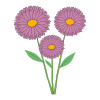Chrysanthemums, often referred to simply as mums, are a popular and vibrant group of flowering plants in the Asteraceae family. Native to Asia and north eastern Europe, these flowers have been cultivated for over 2,500 years and hold deep cultural significance, particularly in countries like China and Japan, where they symbolize longevity, rejuvenation, and nobility.
Chrysanthemums come in a dazzling array of colours—white, yellow, red, pink, purple, and bronze—and display a variety of flower forms, including daisy-like, pompons, buttons, and spider shapes. Their striking blooms typically appear in late summer to fall, making them a favourite for autumn gardens and floral arrangements.
Beyond their ornamental appeal, some varieties of chrysanthemums are used in herbal medicine and teas, known for their soothing properties. In gardening, they are appreciated for their hardiness, relatively low maintenance, and ability to attract pollinators.
With their beauty, diversity, and cultural richness, chrysanthemums remain a beloved choice for gardeners, florists, and nature enthusiasts around the world.
How To Grow
-
Choose the Right Type
Garden hardy mums (also called garden mums) are best for outdoor growing.
Florist mums are more delicate and usually grown indoors.
-
Planting Time
Best time: Spring (early to mid-spring) so they can establish roots before blooming in the fall.
Avoid planting in the fall unless you live in a mild climate, as they may not survive the winter.
-
Site Selection
Sunlight: Full sun (at least 6 hours a day).
Soil: Well-draining, rich in organic matter, slightly acidic to neutral (pH 6.5–7.0).
Avoid areas with soggy soil to prevent root rot.
-
Planting
Spacing: 18–24 inches apart to allow airflow and prevent disease.
Depth: Plant at the same depth as in the container.
-
Watering
Water regularly, especially during dry spells.
Keep soil consistently moist but not soggy.
Water at the base to avoid wetting the foliage.
-
Fertilizing
Apply a balanced, slow-release fertilizer in early growth (spring).
Once buds form, switch to a fertilizer higher in phosphorus to promote blooms.
-
Pinching Back
Pinch tips of the plant back (about 1 inch) every 2–3 weeks until mid-July.
This encourages bushier growth and more flowers.
-
Mulching
Apply mulch around the base to retain moisture, suppress weeds, and protect roots.
-
Overwintering
In colder regions, after the first frost, cut the plants back to 6 inches and mulch heavily with straw or leaves.
In milder zones, simply cutting back and light mulching may be enough.
-
Pest and Disease Control
Watch for aphids, spider mites, mildew, and rust.
Use insecticidal soap or neem oil if needed, and avoid overhead watering to minimize disease.
How/When To Harvesting
-
Timing the Harvest
Best time: Early morning or late afternoon when temperatures are cooler.
Stage: Harvest when the flowers are just beginning to open — the outer petals should be unfurling, but the centre may still be tight. This ensures a longer vase life.
Avoid harvesting in full bloom, as these flowers won't last as long once cut.
-
Tools Needed
Sharp scissors, garden shears, or floral snips.
A clean container or bucket filled with cool water.
-
How to Cut
Choose healthy stems with strong, unblemished leaves and buds.
Cut the stem at a 45-degree angle about 4–6 inches down from the flower head, or longer depending on your arrangement needs.
Remove any leaves that will fall below the water line in a vase to prevent rot.
-
Immediate Care
Immediately place cut stems in cool water to prevent wilting.
Keep harvested mums out of direct sunlight and heat until you can arrange them.
-
For Drying (Optional)
Hang flowers upside down in a dark, dry, and well-ventilated area.
Allow 2–3 weeks to fully dry if you want to preserve the blooms.
-
Encourage Regrowth
Regular harvesting encourages more blooms by preventing the plant from going to seed.
Deadhead spent flowers regularly during the growing season for continuous blooming.


